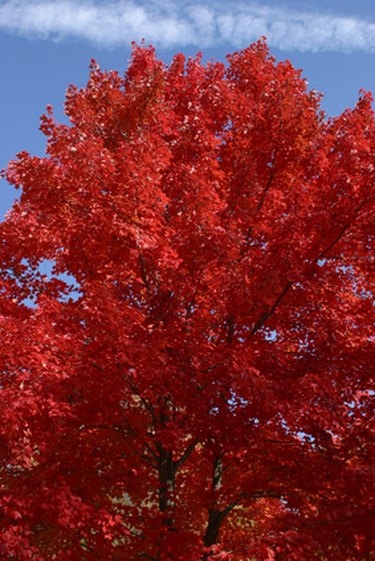
The U.S. Department of Agriculture divides the U.S. into plant hardiness zones. These areas are divided based on their lowest yearly temperature. Plants are rated for the hardiness zones where they will thrive. If you want to plant fast-growing shade trees for zone 9, you should select the plants based on their hardiness rating. A fast-growing shade tree will grow up to 2 feet yearly and will provide shade after six years, according to the This Old House website.
Northern Red Oak
Video of the Day
When grown in the open, a Northern Red Oak tree can reach up to 90 feet tall and 60 feet wide. The tree prefers moist, acidic, well-drained soil and full sun. Trees grown in the open obtain a rounded shape. Upper branches have longitudinal markings that some some growers call ski trails, because that's what they resemble, according to the University of Florida Extension. Red oaks produce acorns that fall from the trees in winter and can be cleaned up with a rake. Leaves alternate on branches and turn red in fall.
Video of the Day
Tulip Tree
Tulip trees may reach up to 100 feet tall and maintain a narrow, oval shape with a straight trunk. These trees prefer slightly moist, acidic, well-drained soil and full sun. The trunks become wide as the tree ages with deep furrows and thick bark. The tree grows rapidly when young, but slows in growth as it ages.
Tulip trees are distantly related to magnolias. The name comes from the tulip-like flowers that form on the tree in spring. Tulip trees have soft wood and are subject to breakage during storms. Leaves are lobed and grow in alternating patterns on tulip tree branches. These leaves turn yellow in fall.
Dawn Redwood
The Dawn Redwood is a plant that exists in the fossil record. The tree has a perfect pyramid shape with feathery deciduous needles that turn orange in fall and an orange-red trunk. The trunk has a sharp taper and a thick base with prominent roots that extend several feet up the tree trunk above the soil line. The Dawn Redwood requires little care and will maintain its shape without pruning. The tree thrives in moist, well-drained, slightly acidic soil.
Eastern White Pine
The Eastern White Pine is an evergreen tree with blue-green needles that grows in bundles of five. The tree can grow up to 100 feet tall with a 5-foot diameter trunk and a spread of 60 feet. Young pine trees grow rapidly, but the growth slows as the tree ages. The tree thrives in moist, well-drained acidic soil and full sun. Windy locations can cause the tree to warp and break. Young white pines appear pyramid-shaped, but older trees have a layered appearance. White pine bark is smooth and silver when young, but takes on a blocky appearance as it ages.
- This Old House: Fast-Growing Shade Trees RSS
- The University of Florida IFAS Extension: Quercus Rubra: Northern Red Oak
- The University of Florida IFAS Extension: Liriodendron Tulipifera: Tuliptree
- The University of Florida IFAS Extension: Metasequoia Glyptostroboides: Dawn Redwood
- The University of Florida IFAS Extension: Pinus Strobus: Eastern White Pine
- The United States National Arboretum